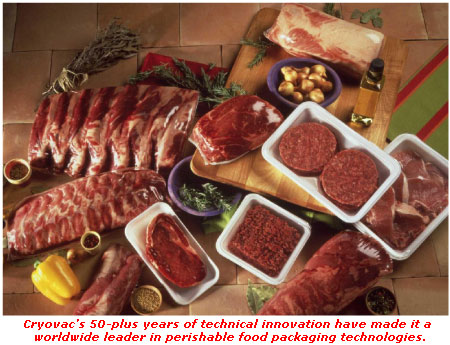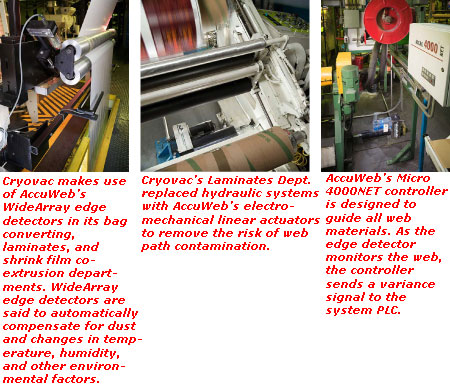Stretching Boundaries
- Published: May 31, 2006, By Edited by Claudia Hine, Managing Editor
Web Guiding
Cryovac's Simpsonville, SC, plant is the size of a small town. With a population of 1,400 and more than 34 acres under one roof, the facility is the result of too many expansions for anyone to count since its grand opening in 1955.
In addition to producing the entire Cryovac perishable food packaging portfolio, Simpsonville serves as a working laboratory for many of the mechanical and electrical engineers in Central Engineering, located up the road in Duncan.
The Duncan campus is the divisional headquarters for Food Packaging, Medical Products, and Shrink Packaging, and it is the site of the primary Research, Development & Engineering (RD&E) Center and the Packaging Equipment Systems Center. Globally, food packaging—like what is produced in Simpsonville—represents 62% of parent company Sealed Air’s total revenue of $3.8 billion. Sealed Air operates more than 100 manufacturing facilities in 51 countries and employs approximately 17,000, including about 2,500 in Duncan.
A Half-Century of Innovation
Sealed Air’s Cryovac division has more than 50 years of experience in the development of flexible packaging materials for fresh foods. Many of the technical innovations in packaging materials and equipment systems helped shape the way fresh food is brought to market in the US and throughout the world. Sealed Air holds more than 3,000 patents and reportedly invests twice the industry average in R&D to ensure its technology leadership. The Cryovac division supports a Food Science department where scientists work on new product applications and groups of technical service specialists install packaging systems, train operators, and provide on-going support and service.

There are also teams of electrical and mechanical engineers focused on internal operations. Their mission is to modify, customize, or design package manufacturing and converting lines for optimum production efficiency. As a result of their efforts, much of the operating equipment in Cryovac plants is unique in the packaging industry, the company says.
Due to its proximity to the division’s headquarters, Simpsonville has been the focus of much development over the years, but its engineering and management staffs have the freedom to make technical decisions appropriate to their specific production needs. According to Andy Taylor, senior electrical engineer, “Cryovac has learned over the years that running large operations like Simpsonville requires well-trained, independent people who strive for continuous improvement in a team environment. We work hand in hand with RD&E to advance practical, engineered solutions to complex challenges.”
To foster this culture, the plant is organized into three distinct and autonomous cells: shrink films, laminates, and bags. Although each operates independently, good news travels fast when it comes to technical innovation.
Edge Detection in a Harsh Environment
The Simpsonville maintenance department has a long history with AccuWeb that stretches from 1998 to the present. Its initial experience focused on overcoming performance challenges in the bag converting department. To prevent bags from sticking in a customer’s packaging operation, the bags are sprayed with an anti-offset powder. This fine food-grade powder was settling on the edge detectors, and this was affecting sensor accuracy.
AccuWeb’s dynamically compensated ultrasonic edge detectors eliminated this problem. With this technology, many overlapping beams of pulsed energy are transmitted across the detector gap. The energy received by the edge detection sensor is converted to a digital web position signal, and the beams that are not blocked by the web provide a continuous reference signal to eliminate guide point drift due to changes in temperature, humidity, dust, dirt, ink overspray, web flutter, etc.
As environmental conditions change, the reference beam, or compensation beam, monitors the conditions in real time and adjusts the web detection beam proportionally to maintain accuracy.
Although one problem was solved, another remained. The anti-offset powder was fouling the automatic edge-seeking mechanisms. The mechanical positioners were needed because the bag web width can vary between 3 and 24 in. on any given production run. AccuWeb already had begun working on a solution and delivered its first WideArray edge detectors to Simpsonville in 1999. The WideArrays did not require edge-seeking devices, because the detection range was larger than the web width variation. All the moving parts were eliminated, providing an elegantly simple fix to a difficult problem.
According to Tony Alexander, senior process engineer at Cryovac, this was an “install and walk away” solution and a “no-brainer” for retrofitting the company’s entire bagmaking operation. To confirm what seemed obvious, Alexander used Cryovac’s maintenance work order tracking system to justify the continued investment.
Removing Hydraulics
What was happening in bag converting did not go unnoticed by other departments. In Laminates, more mechanical positioners were replaced with the WideArrays on six- and eight-color flexo printers and coater/laminators.
This department also seized on an opportunity to remove the risk of web path contamination by replacing hydraulics with AccuWeb’s electro-mechanical linear actuators. These robust units easily could handle heavy unwind forces formerly reserved for only hydraulics, thus reducing another maintenance headache.
Scott Ford, an electrical technician at Simpsonville, explains, “AccuWeb web guides can be either a simple plug-and-play or a very sophisticated system that allows a lot of functional versatility. They are low maintenance, easy to install, and user friendly for machine operators and maintenance personnel.” Since the plant conducts AIB (American Inst. of Baking) audits to measure its sanitation standards, removing the threat of hydraulic web contamination “was a big step forward,” adds Ford.
Monitoring Web Widths
When Andy Taylor first saw an AccuWeb WideArray at Simpsonville, he immediately envisioned a novel application for the shrink film co-extrusion operations. As a senior electrical engineer in Duncan charged with advancing coextrusion technology, he wondered if this sensor could eliminate the moving parts from web width measurement and control systems. Historically, Cryovac had used mechanical edge chasing with infrared or pneumatic sensors to monitor web widths. The division had designed its own proprietary system to control width once it received a signal from the sensors, but the initial cost, as well as the maintenance cost of the mechanical chasing system, was increasing operating expenses.
By late in the summer of 2000, AccuWeb delivered a Micro 4000NET controller software enhancement for web width monitoring with the WideArray. As the edge detector monitors the web, the controller sends a variance signal to the system PLC. Ladder logic codes then adjust the process parameters, controlling the width to a very tight tolerance.
“The WideArray gave us a higher resolution and enabled our system to provide significantly better control,” says Taylor. “We installed the first ones almost five years ago, and they are still performing flawlessly.”
Spreading the Wealth
Today, the use of WideArray for web width monitoring and guiding and the replacement of hydraulic actuators has spread through Cryovac’s informal network of engineering and maintenance personnel.
AccuWeb web width monitoring and guiding systems now can be found as far from Simpsonville as Epernon, France, or at Sealed Air facilities in places like Santiago, Chile.

As Cryovac continues to invent new food films and packaging systems, its engineering teams are committed to continually stretching the technical boundaries of manufacturing. Based on its 50-year history, Cryovac’s suppliers will be equally challenged.
Cook-Chill Bags Benefit the Disabled
Sealed Air Cryovac has teamed up with Plascon, Traverse City, MI, a provider of manufacturing work programs, to provide materials for cook-chill bags and casings to two workshop locations.
GTP Industries, Traverse City, MI, and North Bay Industries, Rohnert Park, CA, employ 320 workers with disabilities, providing valuable opportunities for jobs, income, and productive social interaction for disabled individuals. These two facilities will produce cook-chill bags for institutions, restaurants, resorts, municipalities, and other food manufacturers around the world.
The materials provided by Cryovac are multi-layer nylon and polyethylene films that are converted into barrier bags for protection from outside oxygen and moisture.
According to David Peterson, Plascon president, “It is an honor to offer the quality and innovation of Cryovac’s cook-chill technology. Cryovac’s quality, combined with our community service philosophy, is a revolutionary way to approach food packaging that makes us incredibly proud.”
CONVERTER INFO:
Sealed Air, Cryovac Food Packaging Div.
100 Rogers Bridge Road
Duncan, SC 29334
864/433-2000; cryovac.com
SUPPLIER INFO:
AccuWeb—accuweb.com





